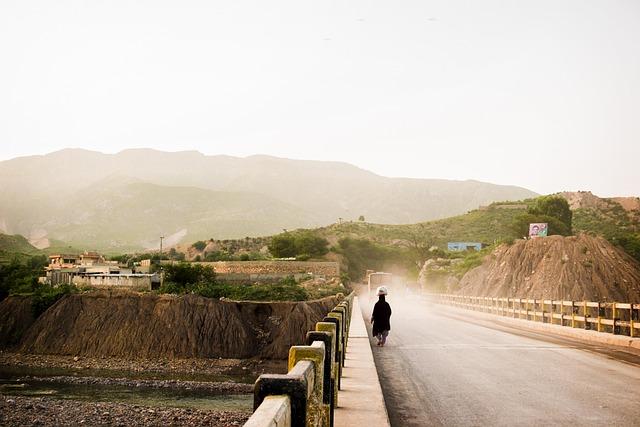Understanding the Rising Wave of Theft in Urban Pakistan
In the heart of bustling cities, where the rhythm of life beats fiercely against the backdrop of ancient history and vibrant culture, a shadow has begun to loom larger: the rising wave of theft. From the crowded bazaars of Karachi to the historic streets of Lahore, urban Pakistan is witnessing an unsettling shift. What once were quaint encounters with neighbors and merchants are now tinged with a growing sense of insecurity. The reasons behind this surge are as multifaceted as the cities themselves, intertwining economic challenges, societal changes, and the evolving nature of urban life. As we delve into the complexities of theft in urban Pakistan, we aim to unravel the layers of this phenomenon, illuminating both the root causes and the human stories that weave through this pressing issue. Join us on this exploration, seeking to understand not just the statistics and headlines, but the deeper socio-economic currents that pulse through the streets of these vibrant cities.
Exploring the Underlying Causes of Urban Theft in Pakistan
Understanding the complex tapestry of urban theft in Pakistan reveals a confluence of factors that transcend mere criminal intent. Socioeconomic disparities, such as high rates of unemployment and inflation, act as significant catalysts. Individuals in lower-income brackets often find themselves compelled to resort to theft as a means of survival, leading to a pervasive culture where desperation often overrides morality. Moreover, the lack of accessible education and vocational training exacerbates this issue, leaving many feeling trapped in a cycle of poverty with few legal avenues for improvement.
In addition to these socioeconomic dimensions, the influence of environment and local governance plays a crucial role. Many urban areas in Pakistan suffer from ineffective policing, creating a sense of impunity among potential offenders. Community engagement can often be lacking, with citizens feeling disconnected from local safety initiatives. This breeds an atmosphere where theft is seen as an inevitable consequence of living in urban settings. Factors such as poor city planning, inadequate lighting, and the proliferation of urban slums further contribute to this unsettling trend.

The Role of Socioeconomic Factors in Urban Crime Trends
The intricate relationship between socioeconomic factors and urban crime trends is vividly evident in the rising tide of theft across cities in Pakistan. As economic disparities widen, individuals facing financial instability may resort to crime as a means of survival. Several key elements exacerbate this situation:
- Poverty: A lack of financial resources often correlates with increased crime rates, as people struggle to meet their basic needs.
- Unemployment: High unemployment rates can lead to desperation, pushing individuals towards theft.
- Education: Limited access to quality education prevents individuals from gaining skills necessary for better-paying jobs, perpetuating the cycle of poverty.
Social disintegration also plays an essential role in shaping urban crime trends. As communities face various stressors, including poor infrastructure and inadequate social services, trust among neighbors weakens, further diminishing the collective efficacy needed to combat crime. The following table encapsulates some of the prevailing socioeconomic indicators and their implications for urban theft:
| Indicator | Impact on Crime |
|---|---|
| Poverty Rate | High poverty often correlates with increasing theft rates, as need drives criminal behavior. |
| Unemployment Rate | Elevated unemployment can lead to heightened criminal activity as jobless individuals seek alternative income sources. |
| Education Level | Lower education levels can lead to fewer employment opportunities, fostering a sense of hopelessness and potential criminality. |

Effective Strategies for Community Engagement and Crime Prevention
In facing the mounting challenge of urban theft in Pakistan, fostering community participation is vital. Engaging local stakeholders can create a robust defense against crime. Here are several effective strategies to consider:
- Neighborhood Watch Programs: Establishing local watch groups allows residents to actively participate in monitoring suspicious activities.
- Community Workshops: Hosting workshops can educate residents on crime prevention techniques, emphasizing the importance of vigilance and awareness.
- Public Meetings: Regular town hall meetings can facilitate open dialogues between community members and law enforcement, fostering trust and collaboration.
- Social Media Campaigns: Utilizing social media platforms to spread awareness about crime trends and safety tips can enhance community vigilance.
Moreover, leveraging technology can augment these strategies, allowing communities to stay connected and informed. The introduction of community apps can enable quick reporting of criminal activity, effectively creating a digital watch group. Here’s a simple table showcasing potential tools that can be integrated into community engagement efforts:
| Tool | Description |
|---|---|
| Alert Notifications | Instant alerts for residents about crimes in their area. |
| Event Calendar | Schedule community meetings and crime prevention workshops. |
| Crime Mapping | Visual maps showcasing reported thefts to highlight trends. |

Policy Recommendations for Enhancing Urban Safety and Security
To address the alarming increase in theft incidents across urban areas in Pakistan, it is crucial to implement comprehensive strategies that focus on prevention, community involvement, and effective law enforcement. Enhancing police visibility through regular patrols in high-risk areas can significantly deter potential offenders. Furthermore, local governments should prioritize investing in advanced surveillance systems and street lighting to improve overall urban infrastructure. A collaborative approach between law enforcement agencies and community organizations can foster stronger neighborhood watch programs, encouraging residents to take an active role in their own safety.
Education and awareness campaigns can also play a pivotal role in reducing theft rates. Workshops and seminars aimed at teaching residents about crime prevention techniques and personal safety can empower communities. Establishing partnerships with local businesses to support such initiatives can amplify their reach. Additionally, the introduction of mobile apps that facilitate immediate reporting of suspicious activity can enhance responsiveness among law enforcement agencies. By fostering a culture of vigilance and cooperation, urban environments can become safer places for all residents.
To Conclude
As we draw the curtain on our exploration of the rising wave of theft in urban Pakistan, it becomes clear that this issue intertwines deeply with the socio-economic fabric of the country. The intricate web of poverty, unemployment, and social unrest paints a complex picture of a nation grappling with its own challenges.
Understanding the motivations behind this surge is not merely an academic exercise; it is a crucial step towards crafting effective strategies for prevention and rehabilitation. As citizens, policymakers, and community leaders come together, it is vital to foster dialogues that transcend fear and stigma, addressing the root causes rather than solely the symptoms.
By acknowledging these realities and amplifying local voices, we can begin to chart a path toward a safer, more equitable urban landscape. The journey ahead may be fraught with difficulties, but through empathy, education, and concerted action, we can hope for a future where the streets of Pakistan’s cities reflect not only resilience but also security and trust. The future calls for engagement, awareness, and a shared commitment to uplift our communities, reminding us all that behind each statistic is a story waiting to be heard and understood.



